Honda CBR250R Tech 2011 Review
When in August we wrote about “the [previously] only Japanese-American 250cc sportbike” – Kawasaki’s Ninja 250R – we did our best to taunt and cajole the remaining three members of Japan, Inc. to bring more 250cc sportbikes to the U.S.Funny how things worked out. It was as if Big Red – which last year lost sales ground to Team Green – decided to throw together its own quarter-liter recipe, if not in response to us, at least to the mighty little Ninja which has enjoyed an exclusive 22-plus-year run as a top seller.
With apologies to Kawasaki, all we can otherwise say is it’s about time!
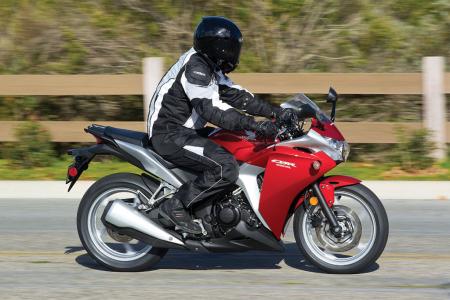 Family resemblance to the VFR1200F – particularly for the red/silver version – is evident. Honda says riders from 5 feet 4 inches tall, up to 6 foot 2 fit well, with maybe some room remaining on either extreme. Family resemblance to the VFR1200F – particularly for the red/silver version – is evident. Honda says riders from 5 feet 4 inches tall, up to 6 foot 2 fit well, with maybe some room remaining on either extreme. |
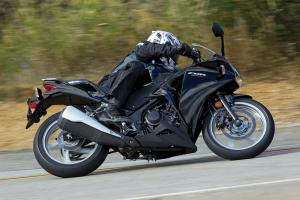 Shown with ABS (with sensor ring inside front rotor carrier), the black version is said to look more like the CBR1000RR to new riders aspiring to their first real motorcycle.
Shown with ABS (with sensor ring inside front rotor carrier), the black version is said to look more like the CBR1000RR to new riders aspiring to their first real motorcycle.Specifically, even as U.S. and European demand continue – but with massive economic question marks hovering over their collective heads – other emerging markets now represent enough buying power for Honda to justify an all-new motorcycle.
According to American Honda’s Senior Product Planning Specialist Tony De Franze, the CBR250R will be seen as an especially cool ride in the 10 ASEAN (Association of Southeast Asian Nations) countries, as well as Japan, Europe, North America and Australia.
Its manufacture in Thailand will be close to its growing eastern markets, and that’s probably good for westerners too. In an era when new Hondas like the VFR1200F are busting the limit of expensiveness, the CBR250R was positioned equal to the bargain-priced Ninja 250R, due in part, De Franze says, to the favorable exchange rate from Thailand.
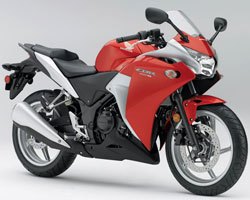 | 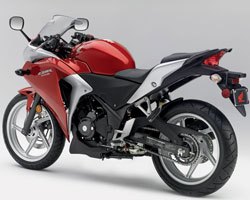 |
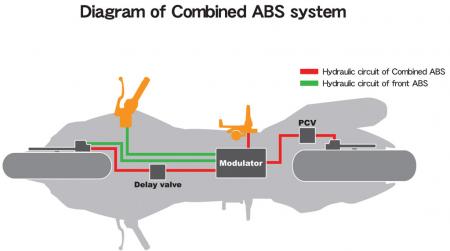 The optional Combined ABS system adds nine lbs, and is positioned so as not to unbalance the bike from right to left. Pressing the rear brake actuates the rear caliper, plus one of the three pistons of the three-piston front caliper (non-ABS has a twin-piston front caliper). The front lever (for ABS or non-ABS versions) actuates the front caliper only. The optional Combined ABS system adds nine lbs, and is positioned so as not to unbalance the bike from right to left. Pressing the rear brake actuates the rear caliper, plus one of the three pistons of the three-piston front caliper (non-ABS has a twin-piston front caliper). The front lever (for ABS or non-ABS versions) actuates the front caliper only. |
Yeehaw! There is hope that more people will discover the joys of motorcycling.
Check out the Honda CBR250R Forum.
The Little Engine That Could
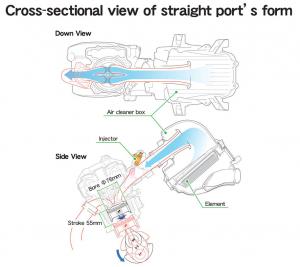 If not as vital for low rpm as it is for high, maximizing flow nevertheless aids engine power. This, plus the bore/stroke and big valves make us wonder what a performance tuner could do to open up this little powerplant for more high-rpm power.
If not as vital for low rpm as it is for high, maximizing flow nevertheless aids engine power. This, plus the bore/stroke and big valves make us wonder what a performance tuner could do to open up this little powerplant for more high-rpm power.Although Honda already has blueprints and tooling to churn out competent single-cylinder powerplants, as is characteristic of the engineering company, it penned a clean-sheet 249.4cc design just for the CBR250R.
Its engine alone has nine patents among 27 total – either granted or pending – for the new motorcycle. Fresh thinking was employed throughout the 359-lb machine (368 lbs with ABS) to make it as contemporary as possible.
Significantly at this price point is inclusion of Honda’s PGM-FI – a catch-all term that in this case denotes a 38mm Keihin throttle body working with computer-controlled ignition with digital transistorized electronic advance.
Honda says it has taken pains to straighten the flow path from intake to exhaust, but this DOHC is tuned for low-to mid-rpm grunt – more so than the parallel-Twin Ninja 250R. This notwithstanding, the 4-valve-per-cylinder’s bore, stroke, and valve sizes, nearly mirror the much-higher-revving CBR1000RR’s.
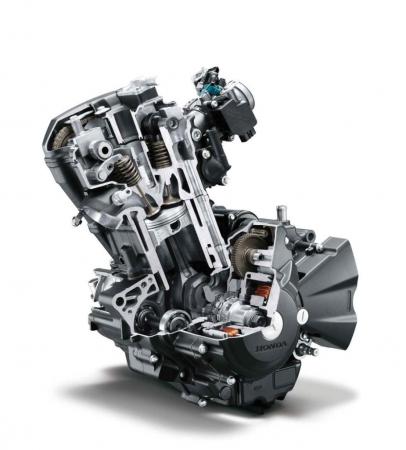 An all-new counterbalanced mill was made just for this world-production motorcycle. An all-new counterbalanced mill was made just for this world-production motorcycle. |
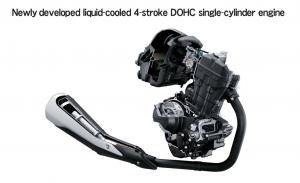
But here’s where the engine’s family resemblance tapers off. The 250’s compression ratio is 10.7:1, while the supersport’s is 12.3:1. The little CBR also lacks the big CBR’s dual 12-hole injectors per cylinder and computer-controlled digital transistorized ignition with three-dimensional mapping, let alone similar cam lift, duration and other high-performance tricks.
No, while the 250R may copy the fire-exhaling 1000RR in some respects, it is designed for low emissions, low maintenance, quietness, and efficiency. To further enhance low and midrange power, Honda says the intake and exhaust system were analyzed and tested to optimize ideal port/pipe length.
Peak horsepower arrives at a sedate 8500 rpm, and a linear torque curve climaxes at 7000 rpm, well below its 10,500 rpm redline.
Compare this to the Ninja 250R’s 13,000-rpm parallel-Twin. At the tire on a dyno, it peaks with 25.4 hp at 10,250 rpm, and 13.2 ft-lb torque at 9500 rpm.
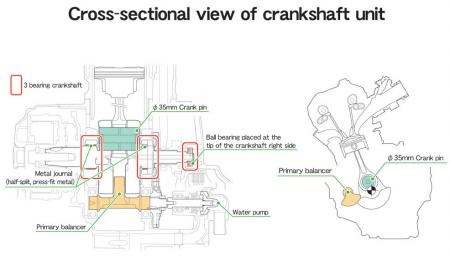 |
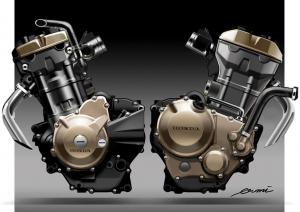
At the wheel, frictional losses will mean about 10-12% less, and when we dyno it, if this proves true, the Ninja will be the more powerful but more peaky. Both bikes allow for substantial over-rev, but Honda’s thumper delivers linear power lower in the rev range.
To handle the abuse Honda’s little engine might still receive from all those first-time buyers, and third-world riders, other innovations include a “spiny sleeve design” for the cylinder sleeve. Small “spines” added to the cylinder sleeve’s outer surface are intended to reduce operating temperatures, and thus distortion to the cylinder’s inner shape. This in turn is said to reduce oil consumption and blow-by gases.
To reduce emissions, an O2 sensor combines with the built-in air injection (AI) system, along with a catalyzer inside the exhaust to scrub the outgoing gasses.
 The primary balancer is placed as close as possible to the crankshaft.
The primary balancer is placed as close as possible to the crankshaft.The moly-coated piston, attached to a lightweight con-rod using a low-friction roller bearing on the big end, itself has a very short skirt. Friction is further reduced, Honda says, because the cylinder centerline is offset 4mm toward the exhaust side thereby reducing the piston’s lateral load against the cylinder wall.
Maximizing efficiency brought about a few “firsts” for a single-cylinder Honda motorcycle engine. One is a lightweight but sturdy crankshaft using a plain bearing to improve crankcase rigidity and control changes in the crank journal’s oil clearance from thermal expansion. At the same time, the design makes the motor quieter.
A vibration-quelling, gear-driven primary balancer is positioned so close in front, that its counterweight passes between the two crank weights to improve engine compactness and mass centralization.
Actuating the low-friction valve train inside the compact cylinder head are forked roller rocker arms. Honda says these are another first for a DOHC Single and are one of the nine engine features being patented.
Another patented innovation is a cooling bypass located inside the cylinder block, negating the requirement for an external hose.
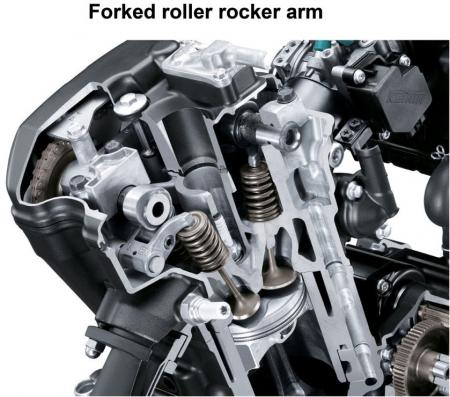 Honda’s patented forked roller rocker arms are a first for a DOHC single-cylinder motorcycle engine. Honda’s patented forked roller rocker arms are a first for a DOHC single-cylinder motorcycle engine. |
Benefitting From Elegant Solutions
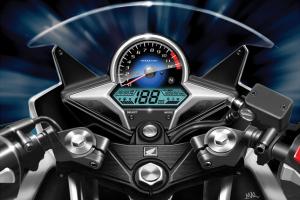 Cockpit view is elemental and functional.
Cockpit view is elemental and functional. All this engineering and more is just what is needed for that new rider to get to school in Philadelphia, or to the Starbucks in Seattle – or to work at the factory in Malaysia, or the call center in Mumbai.
We could go on, but if you are in the generation of new riders expected to buy this bike, according to Honda some of you may not yet know how to operate a clutch. If so, by now your eyes may have glazed over, so we’ll spare you any further agony.
Really, we just write these tech articles to placate the motorheads among us who love to read about machines, and have been at this since before Moses was riding motorcycles.
If you don’t quite know what “rocker arms” are, that’s okay. We’ll cater to you as well and simply tell you what to expect.
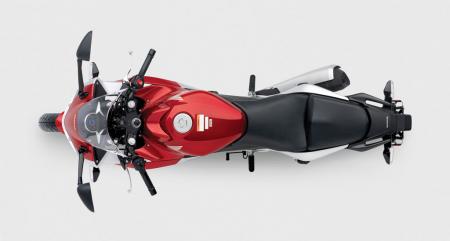 |
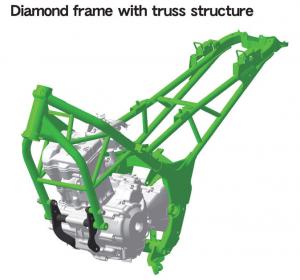 A balance of rigidity and light weight was considered when creating this cost-effective steel diamond frame for the CBR250R.
A balance of rigidity and light weight was considered when creating this cost-effective steel diamond frame for the CBR250R.Shrouded by its VFR-like layered-style fairing, the CBR250R ought to be durable and user-friendly, offering fun even for experienced riders.
Its steel diamond-style frame is old school; simple, but effective. Its fork rake is 25 degrees, trail is 95mm, wheelbase is a short 53.9 inches. These should add up to nimble, but stable handling. And – most important of all – seat height is an unintimidating 30.5 inches.
The CBR250R’s suspension is on par with the Ninja 250R’s, utilizing the same diameter 37mm non-adjustable fork and a rear monoshock with five-position preload adjustability. While basic, the CBR'S 5.1 inches front and 4.1 inches rear travel should nonetheless provide a good compromise in road compliance for a large variety of riders.
If you happen to be exceptionally heavy or lightweight, in either case, the suspension can still be tuned – with more effort – by changing springs or oil viscosity. A shop can help you here if needed, but many will be fine with the bike as set up by Honda.
Seating position is purposeful, but close to that of a standard motorcycle, because – sporty intentions or not – that is what this bike really is.
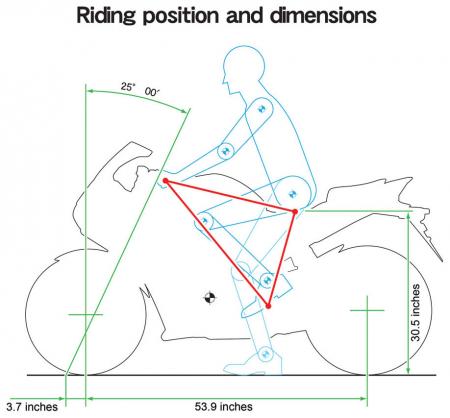 |
A fuel capacity of 3.4 gallons means a moderate throttle hand may get around 200 miles from a tank full, Honda says, although EPA mileage figures are not yet available.
The CBR is a variation on the Ninja 250R theme. Odds are the Kawasaki, although carbureted lean from the factory, will still be a few mph faster.
The standard Honda weighs 16 lbs less (7 lbs less with ABS), which is not much lighter, but an improvement. Its easy-pull clutch will meet somewhat superior low-end torque and make it as user friendly as can be for new riders.
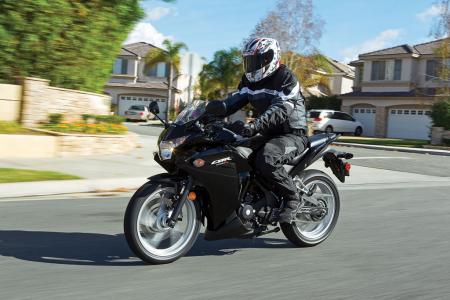 Now there are two out of four Japanese manufacturers importing 250 sportbikes to the U.S. It would be nice to see more competition still, but this is a good start. Now there are two out of four Japanese manufacturers importing 250 sportbikes to the U.S. It would be nice to see more competition still, but this is a good start. |
Another solid contender in this class would be the Hyosung GT250R, and the Bennche Megelli 250R may be worth looking at.
An odd-ball alternative would be Aprilia’s RS125. Until this year, this was an exotic, track-only two-stroke in the U.S. but is scheduled to emerge later in 2011 as a still-exotic but street-legal four-stroke.
While less powerful, its twin-spar alloy frame, wide sticky tires, and high tech throughout make it very cool, albeit probably at more money.
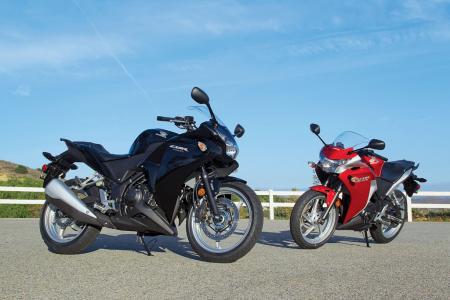 |
The $3999 CBR will come in metallic black or red/silver, with the $500 ABS option available in either color.
 |  |
In the meantime, we’ll look forward to further reviewing the newest Honda 250 against its competitors, and let you know more as soon as possible.
From: Motorcycle.com
0 comments:
Post a Comment